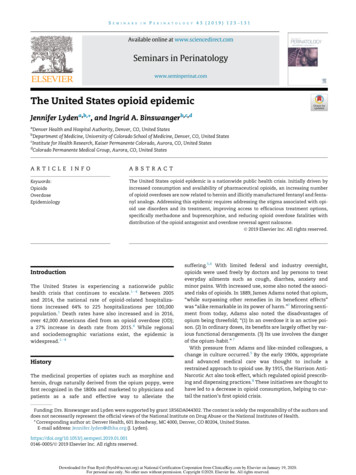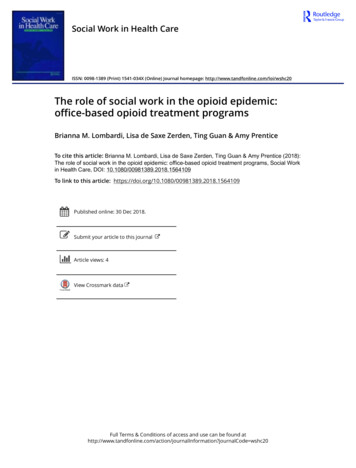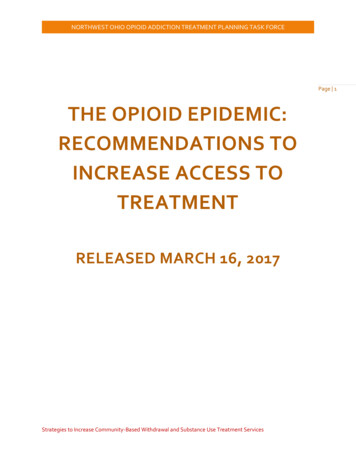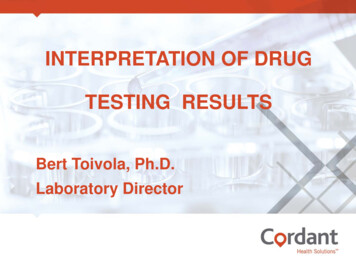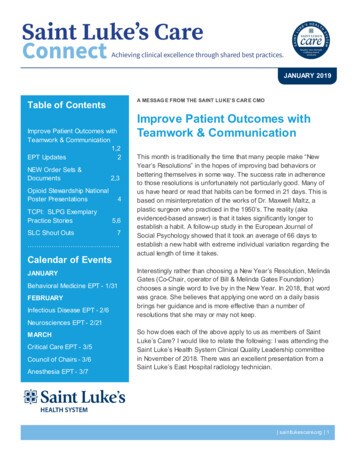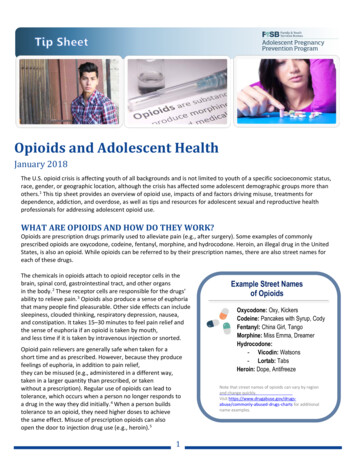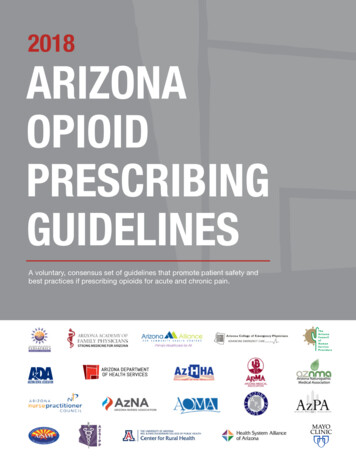
Transcription
The Role of the ClinicalLaboratory in the Current OpioidEpidemicSkyler J. Simpson, MDPGY-1 Pathology ResidentUniversity of Utah and ARUP Laboratories
Conflicts of InterestNo conflicts of interest to disclose
Learning Objectives1. Explain what opioid medications are and their clinical uses2. List the potential short- and long-term consequences of opioid use3. Discuss the different laboratory tests for opioids and their uses
Outline Opioids and their clinical use
What are opioid medications? Opium is an extract of the juice of thepoppy Papaver somniferum that hasbeen used for thousands of years In 1806 Friedrich Sertürner first isolatedmorphine from opium Since that time, many other opioids havebeen synthesized1Pathan H,Williams J. Basic opioid pharmacology.MC. Laboratory testing for prescription opioids. 2012Flower image from Wikipedia.org2MiloneOpiates
Relative Potency of Opioid medications Carfentanil- used as anelephant sedative, is 100times more potent thanfentanyl ( 10,000xmorphine). Heroin hasbeen found laced withit.Image from tion.html
Clinical use for opioid medications Opioids are mainly used for acute and chronic pain. Not great evidence for neuropathic pain relief. Other uses: cough suppressant, anti-diarrheal medication (loperamide)3Ritter,JM et al. Rang and Dale’s Pharmacology. 9th edition.
What is pain? Pain signals are generated by the releaseof certain chemicals when tissue isdamaged. These signals are then sent to the brainfor interpretation Pain has a protective function3Ritter,JM et al. Rang and Dale’s Pharmacology. 9th edition.
Opioid medications mechanism of action Act on same receptors as our “naturalopioids”- enkephalins and endorphins Act mainly in the central nervoussystem to provide analgesic effectsthrough interactions with themu-opioid receptor3Ritter,JM et al. Rang and Dale’s Pharmacology. 9th edition.
Outline Short-term effects and the opioid epidemic
Acute effects of opioid use Some are desired, others are not Other uses: Reduced GI motility andcough suppression Unwanted effects: Nausea/vomiting,respiratory depression, hallucinations Euphoric effects lead to psychologicdependence3Ritter,JM et al. Rang and Dale’s Pharmacology. 9th edition.
NOpioid intoxicationNOOO Clinical signs and symptoms of opioid overdose: Respiratory depression (major cause of death)SedationPupillary constrictionConstipationNausea/vomiting Opioid Overdose Reversal: Opioid antagonist Naloxone3Ritter,JM et al. Rang and Dale’s Pharmacology. 9th edition.NNNERVEO
OOpioid intoxicationOOONNN Clinical signs and symptoms of opioid overdose: Respiratory depression (major cause of death)SedationPupillary constrictionConstipationNausea/vomiting Opioid Overdose Reversal: Opioid antagonist Naloxone May need higher concentrations of Naloxone depending on opioid3Ritter,JM et al. Rang and Dale’s Pharmacology. 9th edition.NERVEN
Opioid Epidemic During 2016, an estimated48.5 million reported useof illicit drugs or misuse ofprescription drugs withinthe past year. Between 1999 and 2018, 450,000 opioid drugoverdose deaths in the US. In 2018, 67,000 peopledied from drug overdose,70% were opioid /index.html
Outline Long-term effects of opioid use
Long term effects of chronic opioid use Increased tolerance- Desensitization of the mu-opioid receptors(higher doses of drug are needed to produce the same effects) Can be seen within even a few days of repeated administration State of hyperalgesia (increased sensitivity to pain) with prolongedexposure3Ritter,JM et al. Rang and Dale’s Pharmacology. 9th edition.
Opioid Withdrawal Similar to tolerance, physical dependence can develop after use foronly a few days. Abrupt cessation of opioid medications leads to the withdrawalsymptoms (can last a few days): 3Ritter,Increased irritabilityBody shakes/restlessnessDiarrhea, nausea, vomitingExcessive yawningDilated pupilsRhinorrhea (runny nose)Piloerection (hair standing up)Sweating, tachycardia (fast heart rate)JM et al. Rang and Dale’s Pharmacology. 9th edition.Image from melines-treatments/heroin
Opioid Withdrawal Treatment for withdrawal: More opioid medications! Severe withdrawal can be dangerous and potentially life threatening Goal in treatment: Gradual cessation of opioid medications Methadone, Buprenorphine Also of note, opioid overdose reversal agents like naloxone canprecipitate withdrawal by blocking opioid effects.3Ritter,JM et al. Rang and Dale’s Pharmacology. 9th edition.
Outline Opioid laboratory testing
Reasons for Clinical Laboratory Drug Testing Clinical setting: Suspicion for prescription or illicit drug use in a patient (screen)Detect the use of non-prescription opioids (i.e. heroin)Determine if patient is following drug regimen (pain management)Patient in rehab programsMay be needed for organ transplantation or medically-related activities. Social Services: Testing mom or baby for the presence of drugs Other Work drug screens for employment Forensics: Determine drug related deaths, criminal prosecution (i.e. vehiclehomicide)2MiloneMC. Laboratory testing for prescription opioids. 2012
Types of Laboratory Specimens Adults Whole blood, serum, or plasma (More reliable, but shorter window) Urine (Can be dilute and yield false negatives, but longer detection window) Neonates (newborns) Urine and blood (not as good, only detects recent drug use) Umbilical cord tissue (easy to collect, but can have quality issues) Meconium (first stool, harder to collect and can also have quality issues)
Laboratory Testing for Opioids Opioid Immunoassays: Recognizes structure of drugs Decent test for screening (rule out) False positives and negatives Not good for confirming drug presence LC-MS/MS: Separates drugs via chromatography and usesmass spectrometry to look at molecularweights and fragmentation Confirmatory testing Essential testing when there are discrepancies2MiloneMC. Laboratory testing for prescription opioids. 2012
Outline Immunoassays
Opioid Immunoassays Clinical setting use Quick and cheap (point of care) Different immunoassays:1.2.3.4.5.6.7.8.Opiates eFentanylTramadolTapentadol Standard immunoassay in ED maymiss some opioids depending onwhich immunoassays are available2MiloneMC. Laboratory testing for prescription opioids. 2012
Accuracy of Opioid Immunoassays Opiate Immunoassay False positives: Fluoroquinolones (class of antibiotics)Levofloxacin Rifampin (antibiotic) Poppy seed consumption (not really a falsepositive as they contain opiates) This is why most immunoassays use the 300 ng/mLmorphine cutoff and 2,000 ng/mL for federalworkplace threshold2MiloneMC. Laboratory testing for prescription opioids. 2012Paula M, Saiz LC, González-Revaldería J, Pascual T, Alberola C, Miravalles E. Rifampicin causes false-positive immunoassay results for urine opiates. 1998.Image from Pubchem.ncbi.nlm.hih.gov5de
Opiate Immunoassay Method Emit II Plus Opiate Assay, 300 ng/mL morphine cutoff Polyclonal antibody to the drug (morphine) Use the bacterium Leuconostoc mesenteroides enzyme glucose-6phosphate dehydrogenase (G6PD) with bound drugGlucose 6 PhosphateG6PD6 PhosphogluconolactoneNADP NADPHG6PDNADPHNADP 6PGLMorphineG6PNADP and NADPH (340 nm) have differentabsorbance that can be measured viaspectrophotometry
Opiate Immunoassay MethodWith no drug in urine:NADP G6PDG6PWith drug in urineG6PDNADPHNADP phine
Outline LC-MS/MS
Opioid LC-MS/MS Liquid Chromatography is used to separate out compounds in theurine based on size and polarity.www.agilent.comLC-MS/MS image from Dr. Lisa Johnson at ARUP laboratories
Opioid LC-MS/MS Mass-Spectrometry Overview Ionization: Positive mode electrosprayionization (ESI) is one method used Need charge for the mass spec instrument toanalyze the molecule (mass-to-charge ratio, m/z) Mass Analyzer: Separates ions by mass andcharge before the detector Detector: Identify opioid medications andmetabolites based on molecular weight odoneCodeine2MiloneQ1 Mass (m/z) Q3 Mass (m/z) Retention Time .3215.22.48MC. Laboratory testing for prescription opioids. 2012LC-MS/MS image from Dr. Lisa Johnson at ARUP laboratories
Outline Difficulties in laboratory result interpretation
Interpretation of Lab Results This is where the laboratory has an impact in patient care as we try tohelp clinicians with interpretation of results Immunoassays: Have to think about the false positives and false negatives Mass spectrometry based assays: Can be difficult because some drugs are metabolites of others For example, morphine is a metabolite of codeine, making it difficult for us to saysometimes whether a patient is only taking one drug or multiple drugs
arupconsult.com
Outline Clinical Cases
Case #1Is my patient Dr. House?
Case Clinical Information 54-year-old female with a long standing prescription for Tylenol #3(Acetaminophen and Codeine) Clinician was screening the patient for any other drug use Test: Qualitative pain hybrid panel (Mass-spectrometry) Question: Patient claims she has had false positive results forhydrocodone before, is this possible?
arupconsult.com6OylerJM, Cone EJ, Joseph Jr RE, Huestis MA. Identification of Hydrocodone in Human Urine Following Controlled Codeine Administration. 2000.
Case #1 Conclusion Literature: Hydrocodone levels up to 11% ofcodeine levels Talked with medical laboratory scientist to lookat the relative concentration of these drugs: Codeine: 263.9 ng/mL Morphine: 146.5 ng/mL Hydrocodone: 41.7 ng/mL (15.8%) Question: Patient claims she has had falsepositive results for hydrocodone before, is thispossible? This could be consistent with Tylenol #3 use alone6OylerJM, et al. Identification of Hydrocodone in Human Urine Following Controlled Codeine Administration. 2000.
Case #2Can poppy seeds give me these results?
Case Clinical Information Newborn female Mom showed up to labor and delivery and tested positive for opiateson urine drug screen. Physician is concerned for the baby may have been exposed toopioids during the pregnancy and wanted baby to be tested Test: Drug detection panel, umbilical cord tissue Question: Are these results consistent with poppy seed consumption?
Neonatal abstinence syndrome Opioid withdrawal in neonates born to mothers with opioid use disorder Need exposure to opioids during pregnancy such that once these drugs areremoved (birth), the baby starts to have the opioid withdrawal symptoms: HyperarousalSweatingFeverNasal stuffiness/frequent yawningTachypnea (rapid breathing)Vomiting and loose stoolsTremors/jitteriness Usually start to see signs and symptoms in the first 24 hours of life, but canbe delayed until five days of age.7Jansson,LM. Neonatal Abstinence Syndrome. UpToDate. April 09,2020.
Neonatal abstinence syndrome May need to treat the baby with an opioid for similar reasons wetreat opioid addicts with opioid medications Morphine, methadone, buprenorphine Baby cannot be discharged until they are no longer taking these drugs forwithdrawal symptoms Substance abuse during pregnancy is a crime in 3 states: Tennessee,Alabama, and South Carolina.8MirandaL, Dixon V, and Reyes C. How States Handle Drug Use During Pregnancy. Propublica. 2015.
Case considerations Umbilical cord tissue Drugs deposit along the length of the umbilical cord during development Drug detection depends on the quality and completeness of collection anddrug use patterns Cases of positive opioids in the umbilical cord, it is important to ruleout drugs used during delivery (opioids are used for pain withepidurals ) What is the clinical picture of the baby and mother? When I spoke with the client, neither the baby nor the mother were havingopioid withdrawal symptoms despite being inpatients9NewbornDrug Testing - Meconium and Umbilical Cord Tissue. arupconsult.com.
arupconsult.com
Case #2 conclusion Relative concentrations obtained from the medical laboratoryscientist: Morphine: 1.6 ng/g Codeine: 2.1 ng/g Question: Are these results consistent with poppy seed consumption? These relatively close and low concentrations along with the clinical picturewith no opioid withdrawal could be consistent with poppy seed consumptionduring the third trimester Probably would need to be pretty consistent poppy seed consumption tokeep the levels high enough to be detected in the umbilical cord tissue
Outline Summary
Summary1. Explain what opioid medications are and their clinical uses Drugs that act on mu-opioid receptors in the peripheral and central nervoussystem to control acute pain and chronic pain, manage cough throughsuppression, and control diarrhea episodes.2. List the potential short- and long-term consequences of opioid use Short: Overdose with sedation and respiratory depression (potential death) Long: Tolerance and hyperalgesia, addiction, and withdrawal (potential death)3. Discuss the different laboratory tests for opioids and their uses Immunoassays: Quick and cheap, screening test, clinical setting use Mass spectrometry-based assays: Confirmatory testing for use in multiplesettings (i.e. clinical, social services, workplace, and forensics)
References1.2.3.4.5.6.7.8.9.Pathan H, Williams J. Basic opioid pharmacology: an update. Br J Pain. 2012;6(1):11‐16.Milone MC. Laboratory testing for prescription opioids. J Med Toxicol. 2012;8(4):408‐416.Ritter, JM et al. Rang and Dale’s Pharmacology. 9th edition. Analgesic Drugs Chapter 43, 542562.Center for Disease Control and Prevention. dex.htmlde Paula M, Saiz LC, González-Revaldería J, Pascual T, Alberola C, Miravalles E. Rifampicincauses false-positive immunoassay results for urine opiates. Clin Chem Lab Med. 1998; 36 (4):241-243.Oyler JM, Cone EJ, Joseph Jr RE, Huestis MA. Identification of Hydrocodone in Human UrineFollowing Controlled Codeine Administration. J of Analytical Toxicology, 2000; 24 (7), 530-535.Jansson, LM. Neonatal Abstinence Syndrome. UpToDate. April 09,2020. nts/neonatal-abstinencesyndrome?search neonatal%20abstinence%20syndrome&source search result&selectedTitle 1 103&usage type default&display rank 1#H483630858. Accessed on May 20,2020.Miranda L, Dixon V, and Reyes C. How States Handle Drug Use During Pregnancy. Propublica.September 30, 2015. -drug-policies-bystate. Accessed on May 20, 2020.Newborn Drug Testing - Meconium and Umbilical Cord Tissue. arupconsult.com.
Questions?
Apr 09, 2020 · 3Ritter, JM et al. Rang and Dale’s Pharmacology. 9th edition. Opioid Withdrawal Similar to tolerance, physical dependence can develop after use for only a few days. Abrupt cessation of opioid medications leads to the withdrawa


